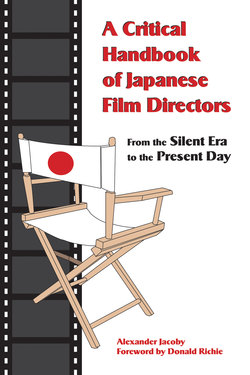Читать книгу A Critical Handbook of Japanese Film Directors - Alexander Jacoby - Страница 32
HONDA Ishirō
Оглавление(May 7, 1911–February 28, 1993)
本多猪四郎
The most famous director of Japanese monster movies or kaijū-eiga, Honda served as assistant at Toho to several directors, most notably Kajirō Yamamoto on Horse (Uma, 1941), Kato’s Falcon Fighters (Katō hayabusa sentōtai, 1944), and numerous comedies starring the clown Enoken (Ken’ichi Enomoto). After war service, he assisted Akira Kurosawa on Stray Dog (1949) before returning to Toho to become a director in his own right, working at first on documentaries. His fiction debut, The Blue Pearl (Aoi shinju, 1951), already revealed an interest in special effects as Honda used an underwater camera to record scenes of women diving for pearls. Eagle of the Pacific (Taiheiyō no washi, 1953) was a spectacular war film, but the course of Honda’s career was fixed by Godzilla (Gojira, 1954), a famous science fiction movie about an attack on Tokyo by a giant lizard, which achieved international distribution in a cut, dubbed version incorporating new footage starring Raymond Burr.
Honda continued to specialize in science fiction for the rest of his career, realizing numerous sequels to Godzilla, including some in which the monster encountered such figures from Western fantasy as Frankenstein and King Kong. Among his other notable monsters was the eponymous giant moth of Mothra (Mosura, 1961). These films retain a considerable sociological fascination: Godzilla’s rampages expressed Japanese anxieties about natural disasters and recalled the wartime devastation of the nation’s cities. Radiation was also a preoccupation: Godzilla was originally woken by nuclear tests, while, in The Mysterians (Chikyū bōeigun, 1957) about an invasion from space, the aliens have suffered genetic damage through nuclear war. Admittedly, these concerns were expressed in the scripts rather than through any directorial subtleties: Honda’s style was generally anonymous and pedestrian. His audiences were doubtless more interested in spectacle than in mise-en-scène, and his technique was likely restricted by the need to showcase Eiji Tsuburaya’s special effects. As evidence, one may note that Matango (1963), which used effects sparingly and was mainly a claustrophobic study of tensions among the marooned survivors of a shipwreck, was rather efficiently directed. Even so, Honda is remembered more because his name happens to be attached to some famous titles than because of any personal distinction. After retiring from direction, he collaborated again with his old friend and colleague Akira Kurosawa, working as an assistant and second-unit director on Kagemusha (1980), Ran (1985), Dreams (Yume, 1990), and Madadayo (Mādadayo, 1993).
1949 Kyōdō kumiai no hanashi / A Story of a Co-Op
1950 Iseshima / Ise Island
1951 Aoi shinju / The Blue Pearl
1952 Nangoku no hada / Skin of the South
Minato e kita otoko / The Man Who Came to Port
1953 Zoku shishunki / Adolescence 2
Taiheiyō no washi / Eagle of the Pacific
1954 Saraba Rabauru / Farewell Rabaul
Gojira / Godzilla
1955 Koi geshō / Love Makeup
Oen-san / Oen-san / Cry Baby
Jūjin yukiotoko / Beast Man, Snow Man / Half Human: The Story of the Abominable Snowman
1956 Wakai ki / Young Tree
Yakan chūgaku / Night School
Tōkyō no hito sayōnara / People of Tokyo, Goodbye
Sora no daikaijū: Radon / Radon, Monster from the Sky / Radon / Rodan
1957 Kono futari ni sachi are / Good Luck to These Two
Wakare no chatsumiuta / A Teapicker’s Song of Goodbye
Waga mune ni niji wa kiezu / A Rainbow Plays in My Heart
Wakare no chatsumiuta: Shimai hen: Onēsan to yonda hito / A Teapicker’s Song of Goodbye: Sisters Chapter: The Person I Called Sister
Chikyū bōeigun / The Mysterians / Earth Defense Force (lit.)
1958 Hanayome sanjūsō / Song for a Bride (lit. Trio for a Bride)
Bijo to ekitai ningen / The H-Man / Beauty and the Liquid Man (lit.)
Daikaijū Baran / Baran, Monster from the East / The Great Monster Baran (lit.)
1959 Kodama wa yondeiru / An Echo Calls You
Tetsuwan tōshu: Inao monogatari / Inao: Story of an Iron Arm
Uwayaku, shitayaku, godōyaku / Seniors, Juniors, Co-Workers
Uchū daisensō / The Great Space War / Battle in Outer Space
1960 Gasu ningen daiichigō / The First Gas Human / The Human Vapor
1961 Mosura / Mothra
Shinku no otoko / The Crimson Man
1962 Yōsei Gorasu / Gorath, the Mysterious Star / Gorath / Astronaut 1980
Kingu Kongu tai Gojira / King Kong vs. Godzilla
1963 Matango / Matango / Matango: Fungus of Terror
Kaitei gunkan / Atragon: Flying Supersub / Undersea Battleship (lit.)
1964 Mosura tai Gojira / Mothra vs. Godzilla / Godzilla Fights the Giant Moth / Godzilla vs. the Thing
Uchū daikaijū Dogora / Dogora / Dagora the Space Monster
Sandaikaijū: Chikyū saidai no kessen / Ghidrah, the Three-Headed Monster / Monster of Monsters / The Greatest Battle on Earth
1965 Furankenshutain tai chitei kaijū / Frankenstein vs. Baragon / Frankenstein vs. the Giant Devil Fish / Frankenstein Conquers the World
Kaijū daisensō / War of the Monsters / Godzilla vs. Monster Zero / Invasion of the Astros
1966 Furankenshutain no kaijū: Sanda tai Gaira / Frankenstein’s Monsters: Sanda vs. Gaira / Duel of the Gargantuas
Oyome ni oide / Come Marry Me
1967 Kingu Kongu no gyakushū / King Kong Strikes Back / King Kong Escapes
1968 Kaijū sōshingeki / Destroy All Monsters! / Monster Invasion (lit.) / All Monsters Attack
1969 Ido zero daisakusen / Latitude Zero / Atragon 2
Gojira, Minira, Gabara: Ōru kaijū daishingeki / All Monsters Attack / Godzilla’s Revenge / Minya: Son of Godzilla
1970 Kessen! Nankai no daikaijū / The Space Amoeba / Yog: Monster from Space (lit. Decisive Battle: Great Monster of the South Seas)
1972 Mirāman / Mirrorman
1975 Mekagojira no gyakushū / The Terror of Mechagodzilla / Revenge of Mechagodzilla (lit.) / Mechagodzilla vs. Godzilla
